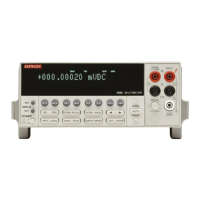Calibration Command Reference
3-13
3.4 :CALibration:UNPRotected Subsystem
3.4.1 :ACCompensation (:CALibration:UNPRotected:ACCompensation)
Purpose To perform user AC calibration
Format :cal:unpr:acc
Parameter None
Description The :ACC command performs user AC calibration, which requires no calibration equipment. All
test leads must be disconnected from the input jacks when performing user AC calibration.
Programming Note Calibration constants generated by using the :ACC command are not stored in EEROM. Thus,
AC calibration constants are in effect only until the instrument is turned off. In order to save AC
calibration constants, perform the comprehensive calibration procedure, then use the :SAVE
command. Note that AC calibration takes about six minutes to complete.
Example :CAL:UNPR:ACC Perform AC user cal.
3.5 Bus error reporting
3.5.1 Calibration error summary
Refer to Appendix C for a summary of calibration errors and additional information on specific
errors.
3.5.2 Detecting Calibration Errors
If an error occurs during any calibration step, the Model 2002 will generate an error message.
Several methods to detect calibration errors are discussed in the following paragraphs. The cal-
ibration programs listed in Appendix B may be used as examples for some of these methods.
Error queue
As with other Model 2002 errors, any calibration errors will be reported in the bus error queue.
You can read this queue by using the :SYST:ERR? query. The Model 2002 will respond with
the appropriate error message, as summarized in Appendix C.
Status Byte EAV (Error Available) Bit
Whenever an error is available in the error queue, the EAV (Error Available) bit (bit 2) of the
status byte will be set. Use the *STB? query or serial polling to obtain the status byte, then test
bit 2 to see if it is set. If the EAV bit is set, an error has occurred, and you can use the
:SYST:ERR? query to read the error and at the same time clear the EAV bit in the status byte.
Generating an SRQ on error
To program the instrument to generate an SRQ when an error occurs, send the following com-
mand: *SRE 4. This command will enable SRQ when the EAV bit is set. You can then read the
status byte and error queue as outlined above to check for errors and to determine the exact
nature of the error.

